History of Persian Scripts:
In the ancient Persia and in the different historic eras, languages such as “Ilami”, “Avestaaee”, “Pahlavi”, and “Farsi-e-Mianeh” were spoken. It is believed that ancient Persian script was invented by about 500-600 BC to provide monument inscriptions for the Achaemenid kings. These scripts consisted of horizontal, vertical, and diagonal nail-shape letters and that is the reason in Farsi it is called “Script of Nails” or “Khat-e-Mikhi”.
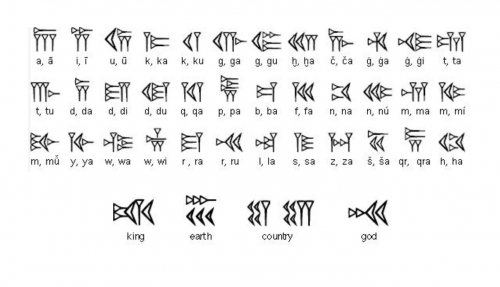
Ancient Persian Script - "Script of Nails" or "Khat-e-Mikhi"
Centuries later, other scripts” scrip such as “Avestaee” and “Pahlavits were created. The Avestan alphabet or “Avestaaee” was created in the 3rd century CE for writing the hymns of Zarathustra. Avestan is an extinct Indo-Iranian language related to Old Persian and Sanskrit. Avestaaee script was related to the religious scripts of Zoroastrians’ holy book called “Avestaa” and unlike the nail script -that was carved on flat stones- Avestaaee script was written with a feather pen, usually on animal-skin pages. It is surprising that this script has similarities with Arabic scripts such as “Sols” and “Naskh” that centuries later were invented. However, unlike these scripts, letters in Avestaaee were not connected to each other to form a word but they just were written separately next to each other (similar to Latin scripts). However it wrote from right to left.
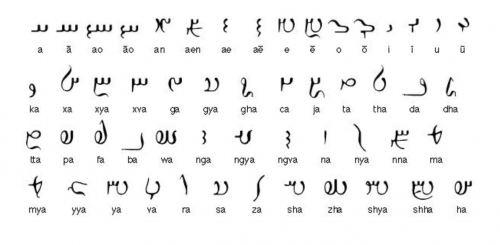

Old Persian Script: "Pahlavi” Script
After initiation of Islam in the 7 th century, Persians adapted Arabic alphabet to Farsi language and developed contemporary Farsi alphabet. Arabic alphabet has 28 characters and Iranians added another four letters in it to arrive at existing 32 Persian (Farsi) letters.
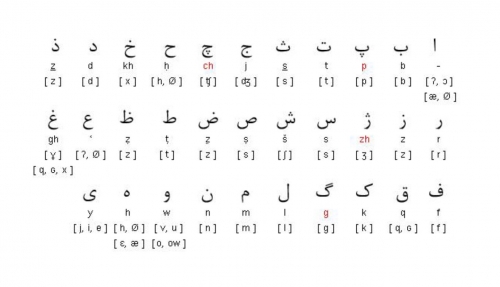
Contemporary Persian Script: "Farsi” Script
Major Contemporary Classical Persian Calligraphy Scripts:
“Nas’taliq” is the most popular contemporary style among classical Persian calligraphy scripts. It is known as “Bride of the Calligraphy Scripts”. This calligraphy style has been based on such a strong structure that it has changed little since that time. It is as if “Mir Ali Tabrizi” has found the optimum composition of the letters and graphical rules so it has just been a little fine-tuned during the passed seven centuries. Nas’taliq is the most beautiful Persian Calligraphy style and also technically the most complicated. It has strict rules for graphical shape of the letters and for combination of the letters, words, and composition of the whole calligraphy piece as a whole. Even the second popular Persian calligraphy style i.e. "Cursive Nas'taliq" or "Shekasteh Nas'taliq" noticeably follows the same rules as Nas'taliq, with more flexibility of course.
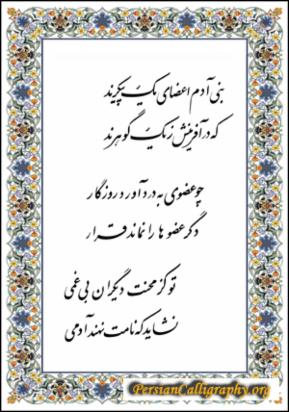
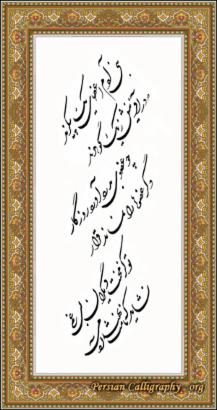
Persian Calligraphy – Nas’taliq Style Cursive Nas’taliq Style (same poem)
History of Nas’taliq:
It was about 10 th century that “Ebn-e-Moqlah Beyzavi Shirazi” conducted a research and studied six major calligraphy styles and categorized them. These styles were "Mohaqqaq", "Reyhan", "Sols" or "Thuluth", "Naskh", "Reqaa", and "Towqee". All of these calligraphy styles followed 12 major principles. After “Ebn-e-Moqlah” another calligraphy master named “Hassan Farsi Kateb” combined “Naskh” and “Reqaa” styles and invented a new style, called “Taliq”. Eventually in the 14th century, “Mir Ali Tabrizi” combined two major scripts of his time i.e. Naskh and Taliq and created the most attractive Persian Calligraphy style, “Nas’taliq”.
Why Nas’taliq is Different?
It is really important to note that unlike its ancestors, Nas’taliq follows natural curves. In other words, unlike Arabic scripts that follow logical/geometrical designs, Nas’taliq follows the nature and natural curves. There are a lot of resemblances found between the curves used in Nas’taliq and natural curves and a few examples are shown here. It is interesting that it may not be the preliminary intention of Mir-Ali or the others to write the letters in such a form that they look like natural curves; but rather later these similarities have been found. Therefore, it shows that it is because of the initial spirit of Nas’taliq and its tendency toward nature that it looks so intimate and beautiful.

Natural Curves in Persian Calligraphy - Nas’taliq Style
History of Cursive Nas'taliq
"Cursive Nas'taliq" or "Shekasteh Nas'taliq" was invented in the 17 th century. This calligraphy style is based on the same rules as Nas’taliqbut it provides more flexible movements. It is a little more stretched and curved. Some believe “Moteza-Qoli Shamloo” is the inventor of this style while others believe it was “MohammadShafeeHeravi” who introduced Cursive Nas’taliq first. Almost a century later, a prominent artist named “DarvishAbdolmajidTaleqani” improved this style to perfection. Among contemporary calligraphers in this style, “YadollahKaboli” definitely ranks in the most prominent place.
History of Iranian Calligraphers Association:
"Iranian Calligraphers Association" is the most reputable Iranian art education organization. It has more than 60,000 students in over 220 branches including its international branches in other countries; Tokyo and Paris branches to mention a few. In 1950, Iranian Calligraphers Association was founded in a collaborative effort by Iranian Ministry of Arts and Cultural Affairs, a few professors of School of Arts such as Mehdi Bayani, and a few prominent calligraphy masters such as Hussein Mirkhani, Ali-akbar Kaveh, Ebrahim Bouzari, and Hassan Mirkhani. Persian art-lovers from all over the country enthusiastically encouraged this Association and its activities and soon after, this organization expanded and opened numerous branches in many cities in Iran.
Persian Calligraphers Association offers courses for different calligraphy styles for art students and conducts nation-wide exams at the end of each semester. There are four major levels in order for the students to pass in a four year program that equals Bachelor of Art Degree. By completion of first, second, third, and fourth years, one may achieve "Motavasset", "Khosh, "Aa-lee", and "Momtaaz" respectively. These names could be translated as "Mid-level", "Nice", "Excellent", and "Brilliant" interpreting quality of the holder's hand-writing. As mentioned before, at the end of each of these four educational years, there is a nation-wide final exam which must be passed in order for graduates to achieve the relevant degree. These exams consist of three major standard sections and several judges review each student's paper based on a variety of criteria. For more information visit Iranian Calligraphers Association website